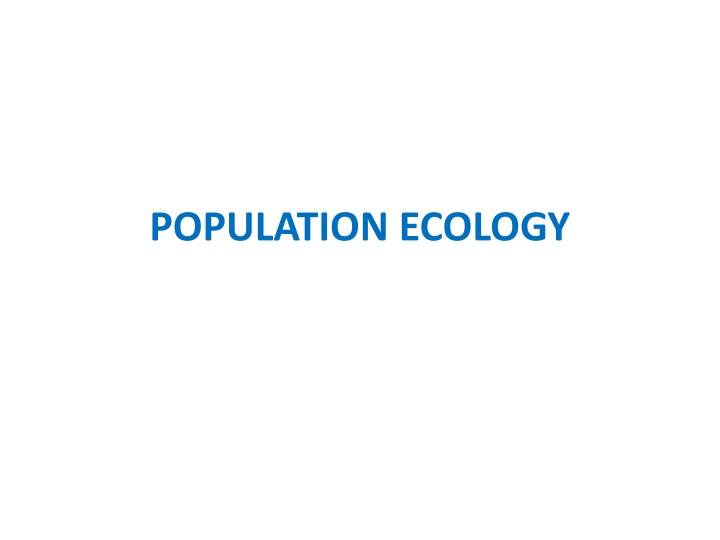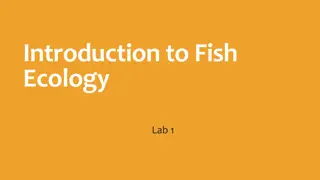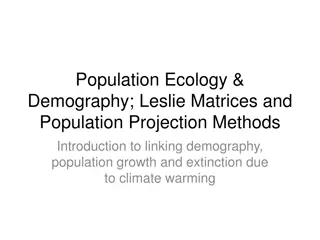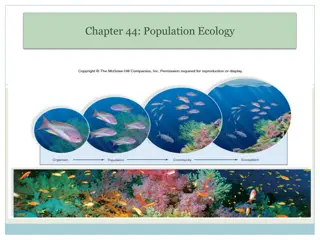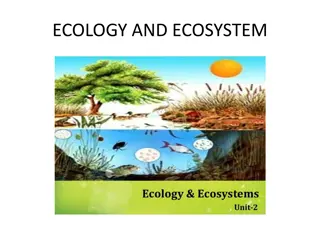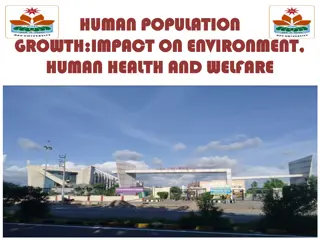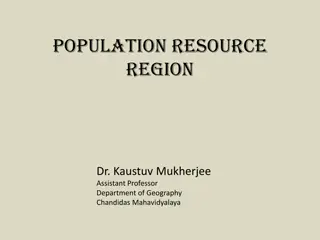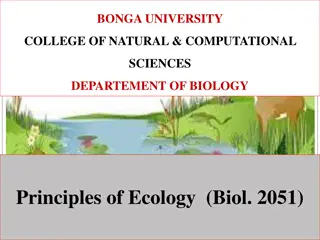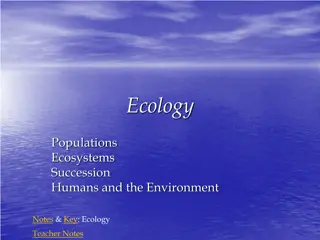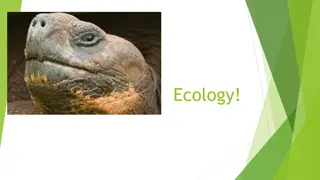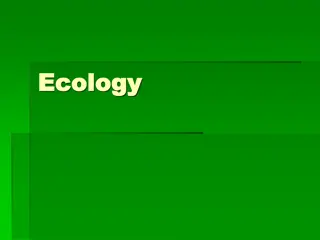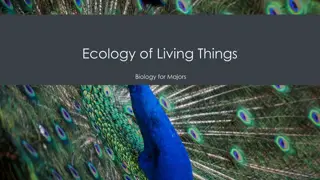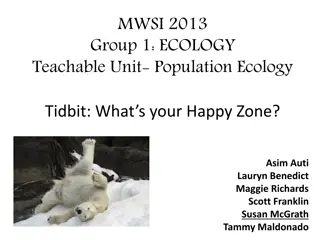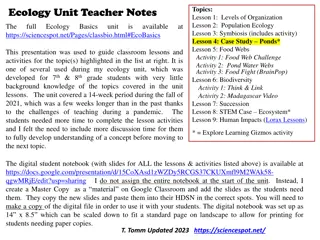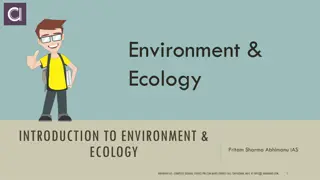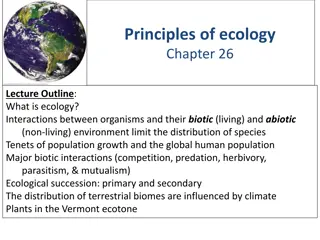POPULATION ECOLOGY
Population ecology delves into the variables impacting the growth, survival, abundance, and distribution of populations over time and space. It encompasses types of populations like monospecific and polyspecific, along with characteristics such as density, natality, mortality, age distribution, growth, fluctuation, equilibrium, biotic potential, dispersal, dispersion, and regulation. Factors like resource availability, competition, parasitism, predation, and climate maintain population boundaries. Understanding population density, natality, birth rate, carrying capacity, mortality, and death rate are key aspects explored in this field.
Download Presentation

Please find below an Image/Link to download the presentation.
The content on the website is provided AS IS for your information and personal use only. It may not be sold, licensed, or shared on other websites without obtaining consent from the author.If you encounter any issues during the download, it is possible that the publisher has removed the file from their server.
You are allowed to download the files provided on this website for personal or commercial use, subject to the condition that they are used lawfully. All files are the property of their respective owners.
The content on the website is provided AS IS for your information and personal use only. It may not be sold, licensed, or shared on other websites without obtaining consent from the author.
E N D
Presentation Transcript
Population ecology is the study of the variables that determine the growth, survival abundance and distribution of population in time and space TYPES OF POPULATION Monospecific population One species. Eg: Catla, Rohu. Polyspecific population Many related species. Eg: Fish, Human, Whale
CHARACTERISTICS OF POPULATION Population Density Natality Mortality Age distribution Population growth Population fluctuation Population equilibrium Biotic potential Dispersal Dispersion Regulation of population density Population interactions.
POPULATION DENSITY The number of individuals of a species present in a defined area is a measure of population density There are factors such as resource availability, competition, parasitism, predation, climate, etc. that usually operate in an ecosystem to keep populations within certain boundaries It refers to The total number of individuals in a unit area or unit volume at a given time No. of benthos / m2. The density N/A/t. Where,D = Population density, N = Eg: No. of bacteria/ litre; No. of plants / acre; of population is expressed as, Number of individuals, T = Time, A = Area D =
NATALITY OR BIRTH RATE Birth rate refers to the average number new individuals produced by a population in a given time due to birth, hatching, germination or fission Natality = Number of birth per unit time Average population Types of birth rate Potential natality Maximum rate of reproduction Realized natality Actual number enter new fish
Carrying capacity It is the total number of individuals that can be supported in an area at a particular time is called carrying capacity Factors influencing are density, pollution, habitat stress, association, disease etc.
MORTALITY OR DEATH RATE Mortality refers to the number of individuals dieing in a population at a given time Vital index The size of population decreases due to mortality Mortality = Number of deaths birth Average population It is the ratio between birth rate and death rate is called vital index Helps to understand the rate of growth of a population Vital index = Birth x 100 Death
AGE DISTRIBUTION A population is formed of individuals in different age groups Birth and death rates and immigration and emigration determine age distribution (proportion of individuals in each age group) of a population Fecundity (rate at which females produce eggs), fertility (rate at which females produce zygotes), and sex ratio (proportion of male and female in the population) affect birth rate
POPULATION GROWTH The increase in size of population is called population growth Population growth occurs when birth rates exceed death rates or immigration exceeds emigration Population size may be regulated by physical factors (weather, water and nutrient availability) and by biological factors (food availability, predators, parasites, competitors, and diseases) Competition for resources, parasitism, predation and diseases are example of density-dependent factors Flood, drought, fire and other climatic conditions and most pest control actions are examples of density-independent factors
Population growth can be explained by using the equation: Nn = Nt + B - D + I - E A population may grow exponentially or logistically (see Fig.) The exponential or geometric population growth curve is described by the formula rN = dN/dt where N is present population size, t is time, r is a constant called the instantaneous rate of population increase
The logistic growth curve dN/dt = rN (K-N)/K where, N, t, r are the same as in the exponential growth model and K is the carrying capacity, or the maximum number of individuals the environment can support When a population is growing in a limited space, the density gradually rises until interaction reduces the rate of increase ultimately leading to a reduction in population growth This is logistic growth and the growth curve is sigmoid or S-shaped The S-curve differs from the geometric curve in two ways: it has an upper asymptote it approaches this asymptote smoothly, not abruptly
POPULATION EQUILIBRIUM After reaching the maximum number, the population remains at that level for a long period this is called population equilibrium The population remains in equilibrium as long as the biotic and abiotic factors are optimum
POPULATION FLUCTUATIONS The increase and decrease in number of individuals in a population is called populationfluctuation BIOTIC POTENTIAL Refers to The inherent ability of a population to increase in number when the age ratio is stable and all environments conditions are favorable It is the reproductive ability a population
DISPERSAL Dispersal is a phenomenon where the individuals (not all) of a population move into or out of the population Allows individuals to colonize new areas Regulates population size, evolution through mixing of genes between populations Dispersal is accomplished through immigration (movement into a population), emigration (movement out of a population) or migration (frequent movement into or out of a population area).
Migration : Periodic movement of animals from one place to another and back for breeding, feeding, and shelter - Fishes, birds, mammals etc. Catadromus Fresh water to sea for spawning. Anadromous Sea to fresh water for breeding. Eg: Eel-Anguilla sp. Eg: Salmons. Trouts etc. Emigration: It is outward migration from a population. It is one way migration and migrant never return commit suicide Eg: Lemming population (Small rodents) Immigration : It is inward migration, one way migration. It changes the structure of a stable population
DISPERSION It refers to the distribution of individuals with in a population
REGULATION OF POPULATION DENSITY The total number of individuals of a species living in an area is called population density. Population grows by reproduction of individuals Eg: An oyster lays about 50 million eggs If all egg hatches, they will form a volume about eight time the size of the earth Though the reproductive rate is high, the population does not increase as expected. This is because the density is regulated. Density dependent factors Density independent factors
Density independent factors They are connected with population density Extrinsic factors. Eg: Food, space, shelter and weather When 100 ornamental fishes are introduced into a small aquarium tank most of them die because of starvation and shortage of space.
Density dependent factors They are intrinsic factors arise within the population during their growth Competition Competition for common resource space food, mate etc. Predation Killing (predator) other animal (prey) for food Emigration - Displacement of organisms Reproductive Decreases the reproductively by increasing the density Diseases Kills the individuals and reduces the population
POPULATION INTERACTIONS Main population interactions are Symbiosis None of the partner affected Competition - Both partners inhabited (Paramecium) Predation Predator benefited, prey is harmed (Loin and Deer) Parasitism Parasite benefited, host harmed (Ascaris and Mary) Commensalism One partner benefitted other partner is neither harmed nor benefitted (shark and sucker fish) Mutualism Eg: Hermit crab and sea anemone Both partners are benefitted
Types of interactions Interspecific Between species Intraspecific Within the species
